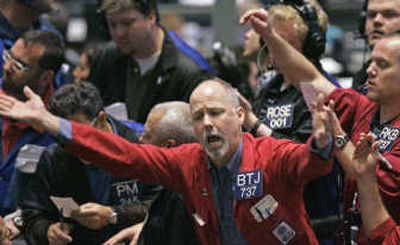Fed makes key interest rate cut

WASHINGTON – The Federal Reserve cut a key interest rate by a quarter-point Wednesday, a smaller move than the aggressive easing it undertook earlier this year. There were signs the Fed may believe it has done enough to prevent a deep recession.
The Fed action, after a two-day meeting, pushed the federal funds rate down to 2 percent, the lowest level since late 2004. It marked the seventh rate cut by the central bank since it began easing credit conditions last September to combat the growing threat of a recession brought on by a severe housing slump and credit crisis.
Commercial banks immediately announced that they were cutting their prime lending rate to 5 percent. That will mean cheaper credit for the millions of business and consumer loans tied to the prime.
The Fed move, which was in line with expectations, sent the Dow Jones industrial average momentarily soaring above 13,000 for the first time since January. But the Dow quickly gave up those gains as traders began to wonder whether the Fed was closing the door to further rate cuts.
Many private economists said they believed a Fed statement was signaling that the central bank may be through cutting rates unless the economy weakens much more than now expected.
“They are saying that unless we are surprised by further weakness, this is it,” said David Jones, chief economist at DMJ Advisors.
Sung Won Sohn, an economics professor at California State University, said, “The Fed is telling us that this easing cycle is coming to an end fairly soon.”
Analysts said the central bank seemed to be balanced between worries about economic weakness and concerns that inflation pressures are increasing. The Fed noted that it had done quite a bit already.
“The substantial easing of monetary policy to date, combined with ongoing measures to foster market liquidity, should help to promote moderate growth over time and to mitigate risks to economic activity,” Federal Reserve Chairman Ben Bernanke and his colleagues said in their statement.
There were two dissents from the move. Richard Fisher, president of the Dallas regional Fed bank, and Charles Plosser, head of the Philadelphia Fed, argued for no change in rates. Both officials had also dissented at the March 18 meeting when the Fed cut rates by three-fourths point.
The central bank is walking a tightrope, trying to jump-start economic growth while also confronting the risk that if it overdoes the credit easing it could make inflation worse down the road.
On the overall economy, the Fed’s statement said, “Financial markets remain under considerable stress and tight credit conditions and deepening housing contractions are likely to weigh on economic growth over the next few quarters.”
While officials said they expected inflation to moderate in coming months, they also said “uncertainty about the inflation outlook remains high.”